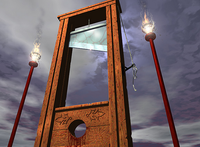








The guillotine is a device used for carrying out executions by decapitation. It consists of a tall upright frame from which is suspended a heavy blade. This blade is raised with a rope and then allowed to drop, severing the victim's head. The device is noted for long being the main method of execution in France and, more particularly, for its use during the French Revolution.
Development
The guillotine became infamous (and acquired its name) in France at the time of the French Revolution. However, guillotine-like devices, such as the Halifax Gibbet and Scottish Maiden seen on the right, existed and were used for executions in several European countries long before the French Revolution. The first documented use of The Maiden was in 1307 in Ireland[1], and there are accounts of similar devices in Italy and Switzerland dating back to the 15th century. However, the French developed the machine further and became the first nation to use it as a standard execution method.
The device derives its name from Joseph-Ignace Guillotin, a French doctor and member of the Revolutionary National Assembly, on whose suggestion it was introduced. Dr. Guillotin proposed the use of a mechanical device to carry out the death penalty. The basis for his recommendation is believed to have been his perception that it was a humane form of execution, contrasting with the methods used in pre-revolutionary, ancien regime (old regime) France. In France, before the guillotine, members of the nobility were beheaded with a sword or axe, while commoners were usually hanged, or more gruesome methods of executions were used (the wheel, burning at the stake, etc.). In the case of decapitation, it sometimes took repeated blows to sever the head completely. The condemned or the family of the condemned would sometimes pay the executioner to ensure that the blade was sharp in order to provide for a quick and relatively painless death. The guillotine was thus perceived to deliver an immediate death without risk of misses. Furthermore, having only one method of execution was seen as an expression of equality among citizens. The guillotine was adopted as the official means of execution on 20 March 1792. The guillotine was from then on the only legal execution method in France until the abolition of the death penalty in 1981, apart from certain crimes against the security of the state, which entailed execution by firing squad.